Statement on Monetary Policy – November 2017 5. Inflation
Inflation has increased over the past year, but remains low. The inflation outcomes over the past couple of years reflect a number of factors including low wage growth associated with spare capacity in the labour market, heightened competitive pressures in the retail sector and downward pressure on rental growth. Working in the opposite direction, there have been large increases in tobacco and utilities prices over the year, while the ongoing activity in residential construction continues to add to inflation in the cost of building a new dwelling.
The trimmed mean measure of inflation declined a little in the September quarter to 0.4 per cent, to be 1.8 per cent over the year (Table 5.1; Graph 5.1) Headline inflation was 0.4 per cent (seasonally adjusted) in the quarter, but was little changed over the year at 1.8 per cent (Graph 5.2). Both measures were a little lower than expected at the time of the August Statement. This reflected unanticipated falls in the prices of volatile items such as fruit & vegetables and fuel in the quarter, while rents and retail inflation were also a little weaker than expected. Overall, the data did not materially change the assessment of pricing pressures in the economy. The December quarter release of the CPI will include updated weights for the individual goods and services in the index (see ‘Box D: Updated Weights for the Consumer Price Index’).
| Quarterly(a) | Year-ended(b) | |||
|---|---|---|---|---|
| September quarter 2017 | June quarter 2017 | September quarter 2017 | June quarter 2017 | |
| Consumer Price Index | 0.6 | 0.2 | 1.8 | 1.9 |
| Seasonally adjusted CPI | 0.4 | 0.4 | ||
| – Tradables | −0.8 | −0.4 | −0.9 | 0.4 |
| – Tradables (excl volatile items)(c) | 0.0 | −0.2 | −1.0 | −0.9 |
| – Non-tradables | 0.9 | 0.8 | 3.2 | 2.7 |
| Selected underlying measures | ||||
| Trimmed mean | 0.4 | 0.5 | 1.8 | 1.8 |
| Weighted median | 0.3 | 0.6 | 1.9 | 1.9 |
| CPI excl volatile items(c) | 0.6 | 0.5 | 1.9 | 1.5 |
|
(a) Except for the headline CPI, quarterly changes are based on seasonally adjusted data; those not published by the ABS are calculated by the RBA using seasonal factors published by the ABS Sources: ABS; RBA |
||||
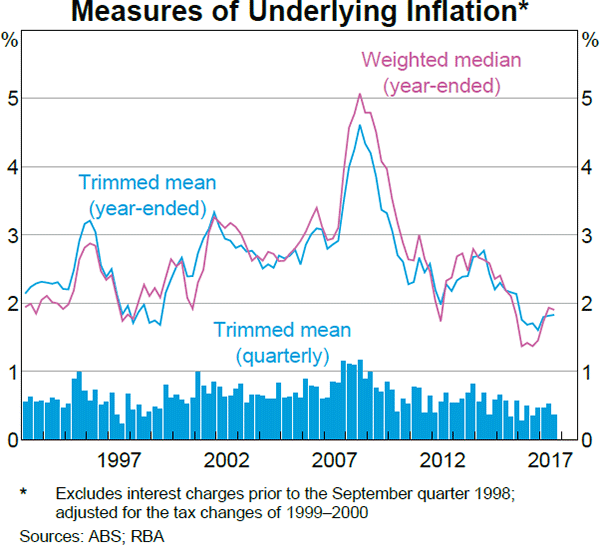
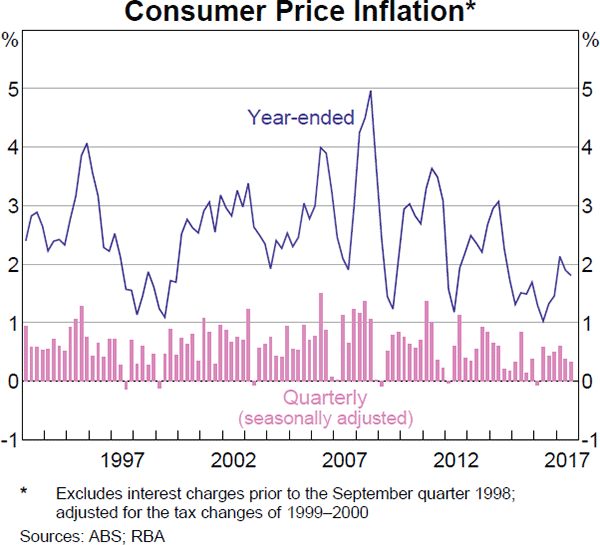
Over the past year, non-tradable inflation has increased, largely as a result of increases in the tobacco excise and utility prices (Graph 5.3). Rising new dwelling costs have also contributed. Inflation in other non-tradable goods and services has been more muted, reflecting low rental growth and subdued growth in labour costs, which account for around two-fifths of final non-tradable prices (Graph 5.4). In particular, labour costs are a large share of final prices for administered prices (excluding utilities) and market services, which have experienced lower-than-average inflation (Graph 5.5). Joint analysis of the micro-level CPI data by the Australian Bureau of Statistics and the Reserve Bank indicates that the average size of price changes for non-tradables has declined since 2013, alongside the decline in wage growth over that period.[1]
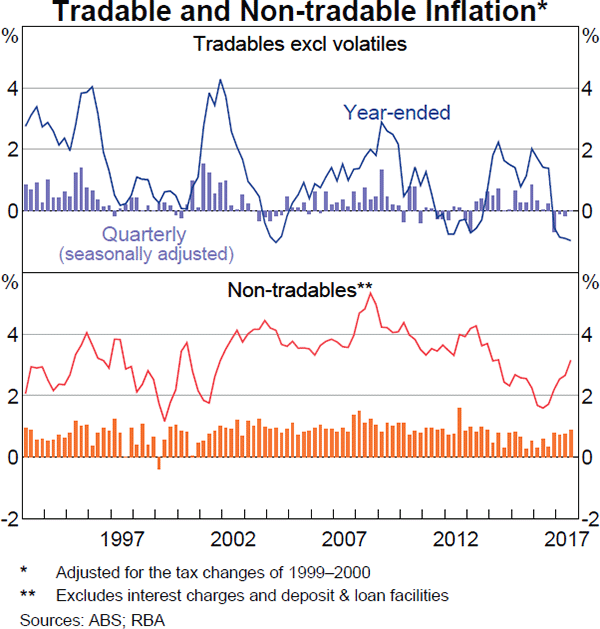
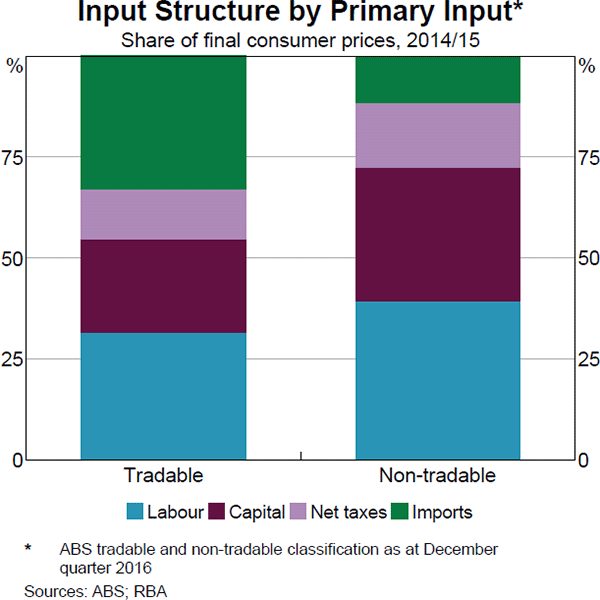
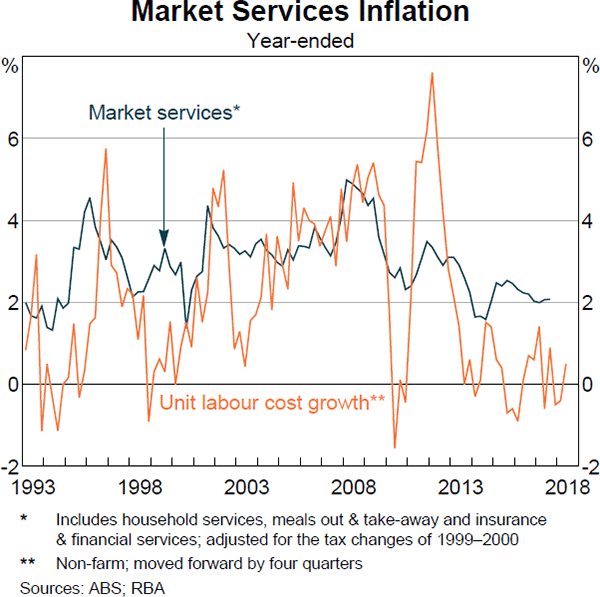
Higher electricity and gas prices boosted non-tradable inflation in the September quarter and over the year because energy retailers in most of the eastern states passed on large increases in wholesale electricity and gas prices (Graph 5.6). The increases in wholesale prices were primarily due to supply constraints following the closure of a few large coal-fired power plants and uncertainty that had dampened investment in generation capacity, as well as increasing demand for gas to meet liquefied natural gas export demand. For the measurement of electricity and gas inflation, the ABS captures both standing offers and market offers. Standing offers are contracts characterised by infrequent but regular price changes, with terms and conditions that are regulated by law. Market offers are non-standard contracts agreed to between an individual and an energy retailer. In the September quarter, market offer rates increased by less than standing offer rates in some states, in part due to competition between energy retailers. Utilities account for around 2 per cent of businesses costs, although these estimates vary by industry. Liaison reports that many businesses have chosen to absorb the price increases in lower margins to date, which suggests the pass-through of higher energy prices to other prices has so far been limited.
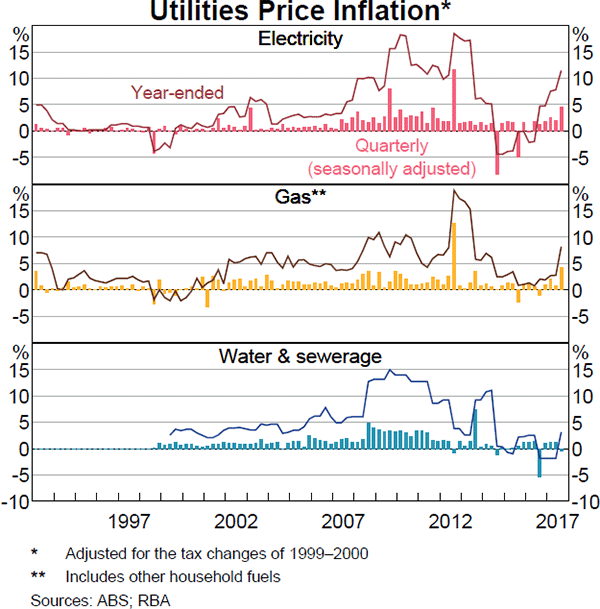
New dwelling cost inflation rose over the year, although trends vary across Australia consistent with differences in the level of residential construction activity (Graph 5.7). The cost of building a new dwelling has fallen in Perth over the year, but has risen in Melbourne and Sydney alongside strong activity in residential construction. The cost of constructing a new house has risen faster than the cost of constructing a new apartment, despite the large volume of apartment development that is currently underway. This could be due to the larger productivity improvements and spare capacity in the construction of office property, which uses similar materials and labour inputs to apartments. Information from the Bank's liaison program suggests that higher utilities prices have contributed to cost pressures for some building materials. Liaison contacts have also reported continued shortages in selected construction skills in some of the eastern states, though there is little evidence to date of increased wage pressures in the construction industry more broadly.
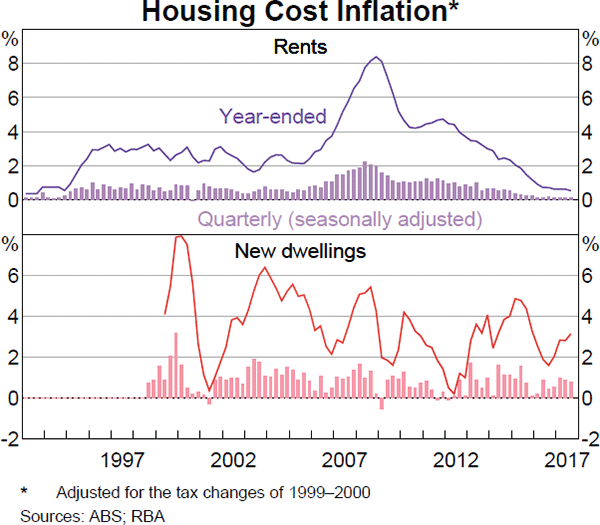
Growth in rents moved lower in the quarter to be at its lowest year-ended rate since the mid 1990s. Conditions vary across cities, reflecting differences in the recent additions to the stock of rental housing, population growth and general economic conditions. Rent inflation has risen a little in Melbourne over the year in line with a decline in the vacancy rate, as strong population growth has absorbed the substantial additions to the dwelling stock. Meanwhile, rents are falling in Perth and, to a lesser extent, Brisbane. Consistent with this, the micro-level CPI data show that nationwide a larger proportion of rents are declining than at any point since at least 2001. Over the next few years, rent inflation is expected to stabilise, but remain well below average, as the additions to the dwelling stock get absorbed by population growth and economic conditions strengthen.
The prices of tradable items have declined over the year. Excluding volatiles, tradables inflation is at its lowest level since the mid 2000s. Final prices of tradable items have a large imported share, so world market prices and movements in the exchange rate are important drivers of these price changes (Graph 5.4). The 8 per cent appreciation of the import-weighted exchange rate over the past two years has assisted in containing cost pressures. However, domestic costs such as labour costs also influence tradable prices. Prices of retail items, which make up 90 per cent of the tradables basket (excluding volatiles) have been dampened by increased competition among retailers, partly in response to new entrants (Graph 5.8). Micro-level food price data indicate that in recent years, retailers have been lowering prices on a larger proportion of their products, but that these reductions in prices have been relatively small. Similar data on clothing prices suggest that seasonal variation in prices has increased substantially, as the average size of product price increases and decreases has more than doubled over the past 15 years.
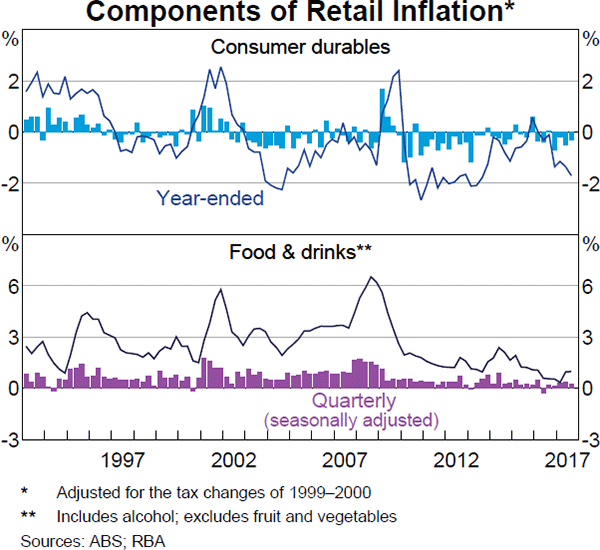
Price declines in consumer durables have been broad based (Graph 5.9). Prolonged discounting has been a strategy employed by retailers to retain market share in an environment of below-average growth in discretionary spending on goods and increased competition from new entrants. Retailers also continue their efforts to contain costs, such as reducing their energy usage and using technology to increase efficiency. The decline in consumer durable prices has been a long-term phenomenon occurring across many countries; advances in technology, and growth in online shopping have all contributed to increased competition between retailers. The arrival of new foreign retailers could be an important influence on consumer durable prices over the next few years.
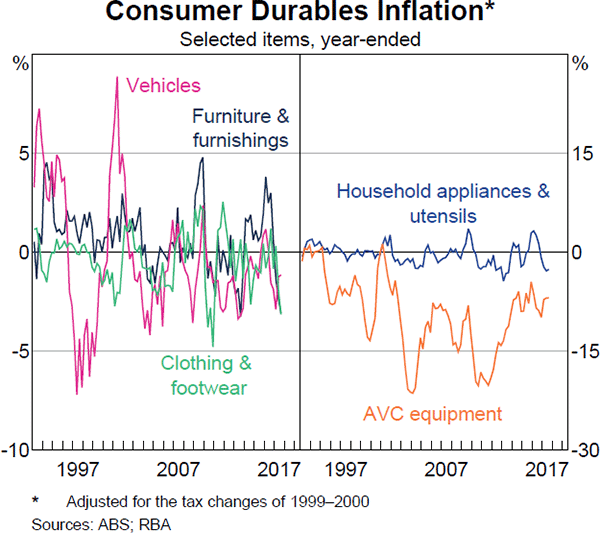
Measures of inflation expectations remain low, although most measures are consistent with the inflation target. Short-term inflation expectations have increased over the past year (Graph 5.10). Long-run Consensus expectations were unchanged at 2.5 per cent in October, consistent with other measures of long-term inflation expectations (Graph 5.11).
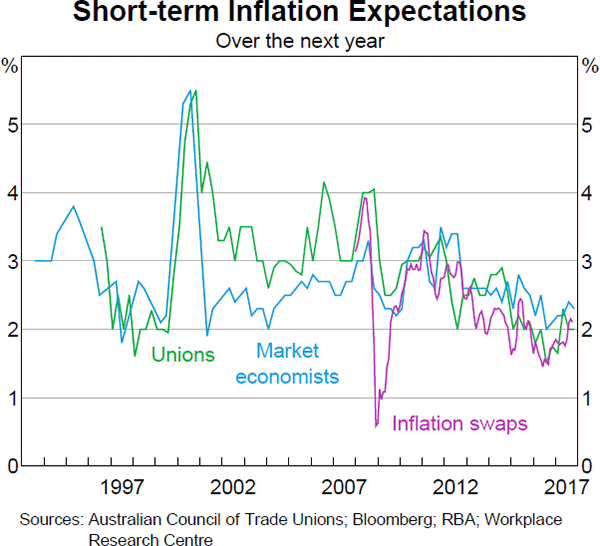
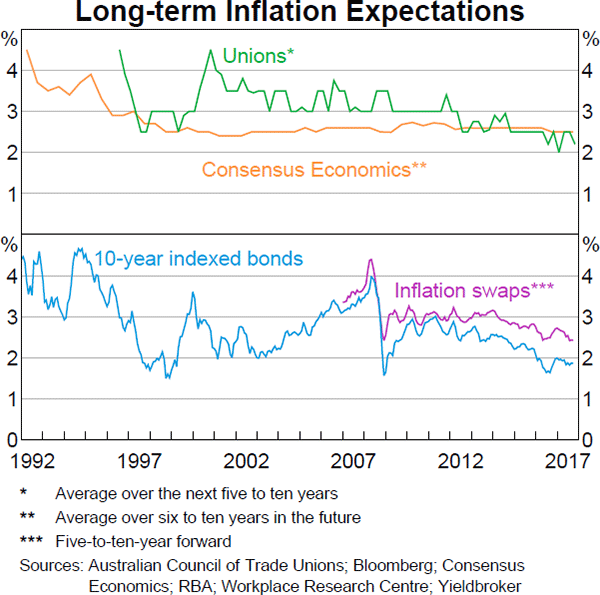
Footnote
For further information, see Sutton (2017), ‘Feature Article: The Average Size and Proportion of Price Changes in the CPI’, Consumer Price Index, Australia, September. [1]